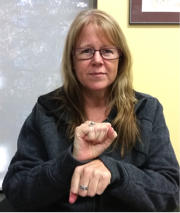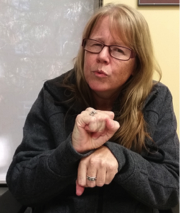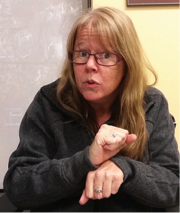American Sign Language
| Details | |
|---|---|
| Course Code | ASLA |
| Co-ordinator | Denise DeShaw |
| Levels Offered | 1st, 2nd, 3rd, 4th year | Full course list * * Not all courses are offered every term. Please check Carleton Central and/or the Public Class Schedule for course availability. |
IMPORTANT
All students must complete a Language Background Questionnaire (LBQ) prior to enrolling in a language course at Carleton and a placement test may be required for students with previous knowledge of the language. Click here to learn more.
Study American Sign Language (ASL) at Carleton University
We have a strong ASL program here at Carleton, and you can take courses at all levels. Our courses will teach you how to use ASL to communicate with members of the Deaf and Hard of Hearing communities.
As a language, ASL focuses heavily on expressing ideas and on seeing these ideas understood by others. As a result, our classes incorporate lots of practice and intensive feedback.
Instructors are a mix of both Deaf and Hearing and each brings to their teaching a passion for the language and for sharing this passion with their students.
ASL proficiency may be particularly useful on certain career paths: social work, speech pathology, audiology, and/or education to name a few.
However, like learning any language, the process itself can also be deeply rewarding. This is uniquely true of ASL as it teaches you to communicate not verbally as most of us are accustomed to, but rather through the movement of our bodies, gestures, and facial expressions.
About the Language
ASL is a language much more rich and diverse than simply a series of hand shapes. Signed languages have been around for centuries and today researchers suggest that there are approximately 300 varieties worldwide.

As the name suggests, American Sign Language (ASL) is the sign language used by members of the Deaf and Hard of-Hearing communities in the United States and Canada.
The language consists of both (a) visual representations created through the movement of hands, body, and arms to present ideas, and (b) facial expressions to give inflection, tone and grammatical signals. For example:



These movements and expressions, in turn, fit together in a systematic way that can be explained logically using clear linguistic principles and systematically developed concepts of how to convey meaning visually.
But ASL is more than a system for communication. It also serves a powerful cultural function for members of the Deaf and Hard of Hearing communities, providing a sense of belonging, connection, and shared experiences.
IMPORTANT: The “Certificate in American Sign Language” is currently suspended.
Registration Information
Space in language courses is limited. Register as early as possible. If the course is full when you attempt to register, please submit a Registration Override Request.
Alumni Profiles (ASL Minors)

Cassidy Knopp
- Minor in ASL

Lindsay Richardson
- Minor in ASL